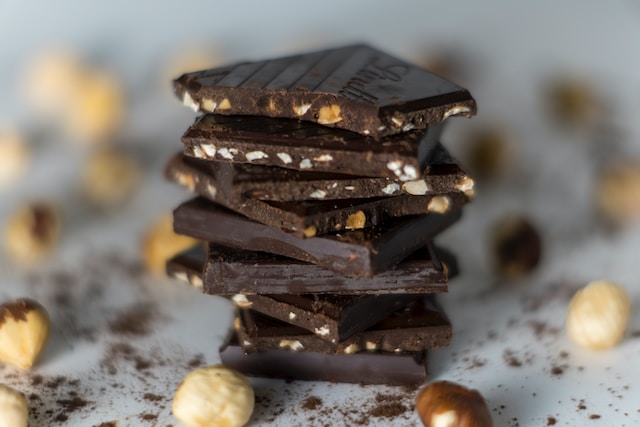The positive aspects of dark chocolate that you have heard are basically all true. It has the ability to safeguard our hearts and supply us with essential nutrients for general good health. Furthermore, dark chocolate contains more antioxidants than some supposedly healthy meals.
Does dark chocolate have a dark side? Not all the “news” is good here; despite its health advantages, dark chocolate is not recommended to be ingested in large amounts. Even with dark chocolate, the adage “in moderation for everything” holds true.
Basic Info on Dark Chocolate:
How is chocolate, in general, made? Well, from the beans growing on the cocoa tree. The beans are harvested from the tree, separated from their pods, fermented, dried, and then roasted.
The beans are processed into a liquor or cocoa mass that can then be pressed to create butter, which is made from cocoa, and cocoa cake for powder production. Dark chocolate can be made by combining cocoa liquor, cocoa butter, sugar, and vanilla.
Dark chocolate is categorized based on the quantity of cocoa solids, also referred to as plain chocolate. It must have at least 70% cocoa content in order to be sold as chocolate.
History and Origins of Dark Chocolate:
A 4,000-year history can be found in the cocoa bean. Despite its bitter taste, the Inca and Mayan monarchs of antiquity drank little amounts up to 50 times daily to boost virility. It was also believed to improve focus, stamina, energy, and happiness. Cocoa beans were used as money in the 1500s because they were valued so highly.
A Dutch chemist C.J. van Houten created a cocoa press in 1828 that could extract the cocoa butter out of roasted beans before grinding them into a smooth powder. Instead of drinking it, the powder might be combined with other components and poured into molds. The first consumable bar of chocolate was created in Britain in 1847.
Thirty-two years later, Rodolphe Lindt enhanced the flavor and texture and started mass production. In the latter part of the 1800s and early 1900s, the first chocolates produced during the era were made by Cadbury, Mars, and Hershey.
The Dark Chocolate’s Supposed Health Advantages:
It should come as unsurprising that dark chocolate is healthy. Cocoa has been used for its therapeutic benefits for many centuries. The theories of our ancient ancestors are now supported by study.
1. Diabetes:
This chocolate decreases blood sugar levels, unlike other types of chocolate. By increasing the body’s sensitivity to insulin, cocoa lowers the incidence of diabetes of the type 2 variety.
2. Heart Wellbeing:
Dark chocolate’s flavanols and magnesium help to improve the circulatory system by keeping the arteries open and regulating heart rate. According to a study, eating chocolate twice or more a week reduces the incidence of plaque with calcification in arteries by 32%.
3. Lowers Blood Pressure:
The flavanols and magnesium in chocolate have health advantages beyond just the heart; they can help lower blood pressure. Your risk of a stroke, cardiovascular disease, and dementia is reduced by lower blood pressure.
4. Functions of a Brain:
Dark chocolate reduces inflammation and improves blood circulation to the brain. It has also been demonstrated that minerals found in chocolate lower the risk of dementia and Alzheimer’s disease.
5. Decay in the Teeth:
Due to theobromine’s ability to harden tooth enamel, ingesting dark chocolate may be enough to safeguard your teeth.
6. Asthma:
Due to theophylline, theobromine, and caffeine in chocolate, those who have asthma might not suffer from constricted bronchial passageways and bronchospasms as frequently after eating it.
7. The Inflammatory Process:
People who consumed tiny to moderate doses of chocolate had decreased levels of C-reactive protein, a marker of inflammation, according to an Italian study.
8. Sun Shield:
Long-term ingestion of dark chocolate increases skin hydration, the flow of blood to the skin, and UV resistance. The bare minimum of UVB photons required to elicit redness in the skin 24 hours after exposure is known as the MED (minimal erythemal dose).
After eating dark chocolate for a period of twelve weeks, participants’ MED more than doubled, according to research. Additionally, the flavanols that are found in dark chocolate lessen the stress hormones that damage the collagen in the skin.
9. Boosting Your Mood:
Your levels of endorphins and serotonin may rise as a result of eating dark chocolate, which will lift your spirits and make you feel better.
10. Levels of Cholesterol:
Men who consume cocoa powder have lower levels of oxidized LDL (low-density lipoprotein) cholesterol, which is considered bad. Additionally, it may raise HDL (high-density lipoprotein), known as the “good cholesterol”.
11. Flavonoids:
One of the best sources of flavonoids, which are good for the cardiovascular system, is dark chocolate. In a small trial on dark chocolate consumption done by the National Library of Medicine, findings revealed improved lipid profiles, lower platelet reactivity, and decreased inflammation in women.
12. Aphrodisiac:
Cocoa has been utilized as a kind of aphrodisiac in both modern and historic periods due to its ability to reduce stress and increase vitality.
Has Dark Chocolate Been Connected to Any Health Issues?
Despite all of its health advantages, eating too much dark chocolate still raises some questions.
1. Kidney Stones:
Avoiding dark chocolate may be a good idea for persons who have previously experienced kidney stones or are at an increased risk of having so. Oxalates included in chocolate increase the excretion of oxalate in the urine, which raises the likelihood of kidney stones. Kidney stones are often excruciatingly painful and may necessitate hospitalization.
2. Migraines:
Tyramine, a naturally occurring chemical found in chocolate, could possibly be a migraine headache trigger. The elevated sugar level has the potential to increase blood sugar levels, another migraine cause.
3. Caffeine:
Compared to other chocolate types, dark chocolate has more caffeine. If consumed right before night, consuming too much caffeine can lead to insomnia as well as elevated heart rate, anxiety, irritability, and nervousness. If you plan to have a big chunk of dark chocolate on the same day, think about whether you need to reduce your intake of other goods containing caffeine.
Should You Restrict Your Dark Chocolate Intake?
When it comes to health advantages, dark chocolate packs a powerful punch, but more is not necessarily a merrier. Overindulgence can cause both short-term effects like indigestion and nausea as well as longer-term effects including:
1. Cadmium and Lead Contamination:
Multiple samples containing dark chocolate have contained trace quantities of lead. Chocolate has also been discovered to contain cadmium, a possible human carcinogen. Nobody is exactly certain of how these ingredients end up in chocolate.
One theory holds that lead is absorbed by the cocoa plant through a natural mechanism, however, a different study found that lead contamination happens throughout the shipping and manufacture of the cocoa bean. Additionally, the fertilizers and herbicides applied to the cocoa trees include lead and cadmium.
Other foods including cereals, veggies, and nuts also contain cadmium. Dark chocolate has very little cadmium since we eat more of these items than we do of dark chocolate.
2. Sugar:
Even though dark chocolate may not have as much sugar as a few of the other varieties, it still has substantial amounts that are bad for you. Because of the quantity of calories in the sugar and fat, it is referred to as a calorie-dense food. Your risk of being overweight and having cardiovascular disease rises with calorie intake.
What Sets Dark Chocolate Apart from Milk Chocolate?
The amount of cocoa in dark chocolate is the key distinction between it and other types of chocolate. Dark chocolate must have at least 70% cocoa content to be considered such. The health advantages increase with increasing cocoa content.
The sugar level of the chocolate is another important indicator of the differences between dark and other types of chocolate. Prior to the components for cocoa, sugar is listed for milk chocolate.
Check for sugar levels on the packaging to make sure cocoa has been indicated first if you are not sure whether it is dark chocolate. To make milk chocolate less bitter, milk solids are added.
The Cocoa in It Is What Makes It Healthy for You
The amount of cocoa contains the solution. Dark chocolate’s 100-gram bar with a cocoa content of 70% to 85% will contain the following fiber and minerals:
- magnesium at 58% of RDA;
- 67% of the iron-RDA (recommended daily allowance);
- 98% of the manganese-RDA;
- 89% of the copper-RDA;
- 11g of fiber;
- Potassium, phosphorus, selenium, and zinc are among other minerals found in dark chocolate.
Due to the quantity of sugar and calories in 100g of dark chocolate, you probably would not want to eat that much every day, but even less still provides a variety of minerals for excellent health. Because dark chocolate has more saturated and monounsaturated fats than polyunsaturated fats, its fatty acid composition is also ideal.
When compared to milk chocolate, dark chocolate has as much as six times the amount of antioxidant catechins. According to a study of the Healthline website, cocoa, and dark chocolate have even more polyphenols and flavonoids, which are antioxidants, than blueberries and acai berries.
Comparison of 70% and 90% Dark Chocolate:
Flavonoids and other phytochemicals are a part of what gives chocolate its color. The chocolate gets darker the more flavonoids there are. The more health advantages it has, the darker the color. A chocolate with 90% cocoa content will therefore appear darker than one with 70% cocoa content.
The logical question imposes itself: Does the number of calories alter depending on how much cocoa is consumed Numerous studies have examined the nutritional value of dark chocolate. The number of calories in dark chocolate is a question that many consumers with weight issues have.
A 100g block of well-known chocolate will have 560–590 calories depending on whether it contains 70% cocoa or 90% cocoa. The distinction in calories while eating less than 100g will be insignificant.
What Chocolate Should You Get?
Now that there are numerous dark chocolate brands available, choosing one to purchase can be challenging. Sadly, a few of them are milk chocolate rather than black chocolate. To determine whether chocolate is healthy or not, look at some of the components and manufacturing processes. The next time you go shopping at the grocery store, keep the following advice in mind.
1. “Dutching”
To make dark chocolate less bitter, some of it goes through a chemical process called “dutching”. During the ditching procedure, every vestige of compounds known as flavonoids are destroyed. Look for the phrase “processed with alkali” or “alkalized cocoa beans” on the package of dark chocolate to avoid purchasing it. Dutching is generally referred to as this.
2. Sugar
If sugar appears on the list of constituents before cocoa, the chocolate is more likely to be milk than dark.
3. The “Fair Trade” Stamp
In West Africa’s Ivory Coast, where harvesting of cocoa is carried out through child slavery, a significant share of cocoa beans is grown. Always check the container for the “fair trade” stamp, or choose chocolate that is produced using cocoa harvested without the use of child labor in South or Central America.
4. Organic
You can opt for the freshest and organic produce that will be delivered to you by the best organic meal delivery services, you can pick organic chocolate.
Some companies advertise their chocolate as being certified organic in light of the rising trend for organic foods. Interestingly, all types of chocolate, including milk, dark, and white chocolate, can be organic.
5. Fats
Compound chocolate, a less expensive variety, substitutes vegetable oil for cocoa butter as the source of fat.
6. Soy Lecithin
The most often used genetically modified component in chocolate is soy lecithin. It is an outcome of fermented soybeans and is employed as an emulsifier to stop the separation of water and fat.
Consume Moderately:
With dark chocolate, quality is more important than quantity. After supper, you should only require one or two squares of chocolate to quell your hunger. Compared to milk chocolate, you should not want to eat a family-sized chunk of it. Eating dark chocolate alongside apples may improve heart health – this research conducted by Healthspan.
The flavonoid quercetin, which has anti-inflammatory properties, is found in apple skins. The antioxidant catechin found in dark chocolate helps to keep arteries from stiffening. They can disintegrate blood clots when consumed simultaneously. Slice an apple thinly and dip it in melted dark chocolate for a nutritious treat.
A Shopping List:
If you want to buy dark chocolate that has the most health benefits and was produced responsibly, seek out these ingredients on the packaging:
- 80% cocoa or greater,
- Lack of a line “Processed with alkali”,
- The “Fair Trade” stamp.
Conclusion:
Dark chocolate is, therefore, one of the greatest options if you’re seeking a small delicious treat and a health boost at the same time. Find high-quality dark chocolate by doing some research. It offers a big nutritional punch.










